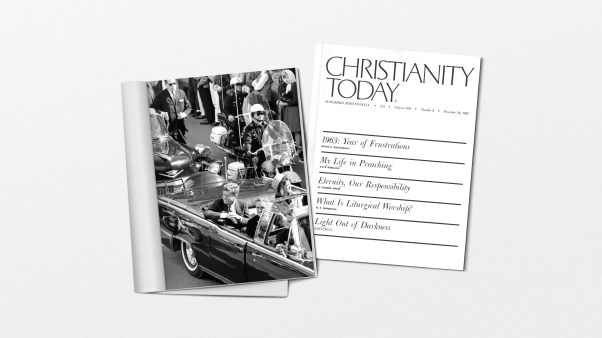Even as a biologist who has studied viruses and immunology, it took a global pandemic for me to realize the true effectiveness of specific hygiene practices to lower illness spread. There is little doubt that church settings provide an almost ideal location for the spread of contagion of all kinds. Churches in ages past responded to changing public health needs, most notably during the 1918 flu pandemic; even the HIV/AIDS crisis spurred research on Communion practices. Churches can and will endure hardships of all kinds, and with COVID-19 still spreading around the world, many pastors are already figuring out ways to adapt.
Congregational singing is getting most of the attention today, but there are so many other opportunities to spread contagious illness at church. The moment you enter, a greeter offers a warm handshake; then church members enthusiastically exchange the passing of the peace with a touch, handshake, or hug. Next, an usher circulates the offering plate around, and then—everyone partakes in Communion.
Will the lessons we are learning now lead to permanent changes in church practices? It’s an interesting question, and only time will tell.
Meeting outdoors
Like all of us, pastors hope to open their churches this summer, but many I’ve met in my work with the science-faith organization BioLogos are taking a cautious attitude and plan to follow official government guidelines, which continue to evolve, before deciding on a precise course of action. Andrew Smith, a pastor in Kennett Square, Pennsylvania, mentioned the likelihood of not holding a separate children’s ministry and said, “we’ll probably look at two services instead of one to allow for social distancing.” Alex Burgess of Ward Hill, Massachusetts, and Steve North of Grand Rapids, Michigan, both mentioned holding outdoor services, weather permitting. During the 1918 pandemic, the benefits of being outdoors was widely discussed and debated among the medical community. Massachusetts Surgeon General William A. Brooks said the efficacy of open-air treatment was “absolutely proven,” and outdoor hospitals were implemented widely.
But would going outdoors really solve the issue? The degree to which ventilation and direction of air currents contributes to spread COVID-19 from a single infectious individual received attention, most notably in a “viral” post by fellow University of Massachusetts Dartmouth biology professor Erin Bromage, which was based on another more lengthy analysis. While it does make sense to scientists that the outdoors would be an improvement over an enclosed area, churches should follow the latest scientific information as it develops on the most effective ways to minimize airborne spread. In the meantime, efforts to avoid exposure to an infective dose is a numbers game, and each small action—such as meeting outdoors—can help minimize how much exposure, if any, a person has to viral particles.
The masked singer comes to church
Photographs from the great influenza pandemic of 1918 show widespread mask-wearing among the populace, just like today. Scientists then understood far less about the cause, and yet most churches during the flu pandemic did what churches should be doing now: They followed guidance informed by data on the best course of action. The 1918 flu went through a series of waves after the initial surge and was controlled by tried-and-true methods of social distancing and mask-wearing. Then as now, areas of the country that relax the most and the earliest will likely experience the strongest upsurges.
Consider the sicknesses that go around every year. Shouldn’t each of us have been doing more to minimize spreading them? Wearing a mask is a gesture of concern for others during a time when an illness is raging, and at this moment it seems obvious that anyone with a sick household member should wear a mask.
In Asian countries, it is common to see people wearing face masks out in public. This has especially been true since the SARS outbreak and 2006 H5N1 flu warnings. The complex reasons for mask-wearing in Asian countries reportedly started with seasonal use in Japan to avoid illness spread but grew to incorporate traditional Asian beliefs about air quality, among other things.
But when was the last time you put on a cloth mask when you had a cold? I never have. Could mask-wearing when sick become a normal part of life in more of the world? Maybe in the future new normal, we will all do more to prevent the normal spread of illness to our friends, neighbors, and grocery store workers.
BYO Communion?
Today, Communion is celebrated in diverse ways, each varying in its degree of potential for germ spread. I grew up in a church that passed a tray of tiny plastic cups. Each congregant took one and passed the tray along. In other congregations, consecrated bread is dipped in the cup/wine by a priest, and then placed on the tongue (called intinction), or the cup is shared. The movement away from use of a shared single cup reached its height with the publication in 1897 of an article in The Journal of the American Medical Association that included vivid descriptions designed to evoke a palpable sense of disgust in the reader at the thought of spreading disease through the common cup. The author, Howard S. Anders, reported on the widespread adoption of single cups in a follow-up letter to the editor published in 1900.
Sadly, the single-cup movement also had political and racial overtones—allowing white people to avoid drinking from the same cup as black people—and clearly it is only one of many possible routes of church-associated contamination. Several more recent studies focusing on the healthfulness of Communion were done in the context of the AIDS pandemic in the 1980s and 1990s, and some failed to show measurable spread of some types of disease via Communion. We now know HIV is not spread by casual contact, making the context and justification of such studies suspect in hindsight. Though the single-cup movement was correct that a shared Communion cup is not a good public health practice, this coronavirus outbreak, as well as common colds, flu and such are very likely to spread in churches whether or not Communion is happening. Churches will need to determine how to adapt their practices in ways that best fit their own congregations.
Several of the pastors in my personal network have been working to make Communion more pandemic-proof, including having people bring their own elements. One fascinating variation is from pastor Micah Smith of Vancouver Island, British Columbia. He mentioned that his church tried doing online Communion by pantomime, with no elements, explaining he’d heard of persecuted churches doing this in prison. “I wanted to borrow meaning from that practice of Communion when we don't have full gathering as we can't all be together, rather than everyone grab whatever bread and whatever drink they choose,” he said. “That felt individualistic, and I wanted to feel the loss of our full practice even while observing it.”
Perils of success and lessons learned
Will these practices be permanent? Probably not. While pandemic illness is spreading, we may need to incorporate more drastic measures, yet improved attention to hand washing among Communion preparers and servers should be done as a matter of principle, regardless of the current public health situation. The same goes for singing: I doubt we will see all church choirs wearing face masks in the future, but choir members who have been exposed to an ill family member should consider wearing a mask for the protection of others until the incubation period has passed.
As a society, we have made excellent progress in slowing the spread of the coronavirus, and we continue this effort while observing the terrible consequences for the economy. The strong temptation is to go back to normal as soon as we start seeing fewer infections and deaths. That is happening now in the US. The dangerous side of this success, though, can be premature over-confidence. An epidemiologist recently interviewed on NPR observed: “When your goal is to prevent something, and you do a good job, nothing happens.” Certainly, the lack of an illness in the population is a common justification for not vaccinating children. When was the last time you heard of someone contracting whooping cough? The success of our efforts at lowering the curve in the current pandemic has set us up to relax when we need to remain vigilant. We must base our decisions not on feelings but on careful analysis of epidemiological data, which is imperfect and ever-changing.
Many claim that we can rely on naturally acquired herd immunity. However, herd immunity may only be achievable by vaccination. Herd immunity was never naturally achieved for measles, which killed thousands every year before an effective vaccine was developed. The World Health Organization estimates that over 20 million deaths have been prevented by the measles vaccine alone. For COVID-19, the examples of individuals (superspreaders) who unknowingly spread the virus to a large number of people means that a high percentage of the population would need immunity for the herd effect to reliably protect the non-immune-protected. Until a much higher fraction of the population has achieved immunity to COVID-19, an increase in social connectivity without precautions is very likely to be followed two or three weeks later by a climb in new cases. While we proceed with re-opening, we must remain cautious until a vaccine is available and remember that the health-compromised, poor, and elderly will suffer most when these upticks occur. It is not possible, practical, or even desirable to completely separate ourselves from these members of society and thereby fully cocoon them. Rather, we must all work together to minimize spread in diverse and practical ways until a vaccine becomes widely available.
Wherever two or more gather, there is the chance of spreading an illness––whether it be on a cruise ship, in a prison, at an assisted living facility, or even at your church. But COVID-19 can teach us valuable lessons that can help us to know how to react when the next pandemic-causing bug inevitably jumps into the human population somewhere in the world. While we cannot prevent all contagious illness from spreading, we should consider our individual role in protecting “the least” among us (Matt. 25:40) by our practices related to personal hygiene.
Craig Story is professor of biology at Gordon College in Wenham, Massachusetts. In addition to his teaching, he has worked with church leaders and seminary professors on issues related to biology and Christian faith.









